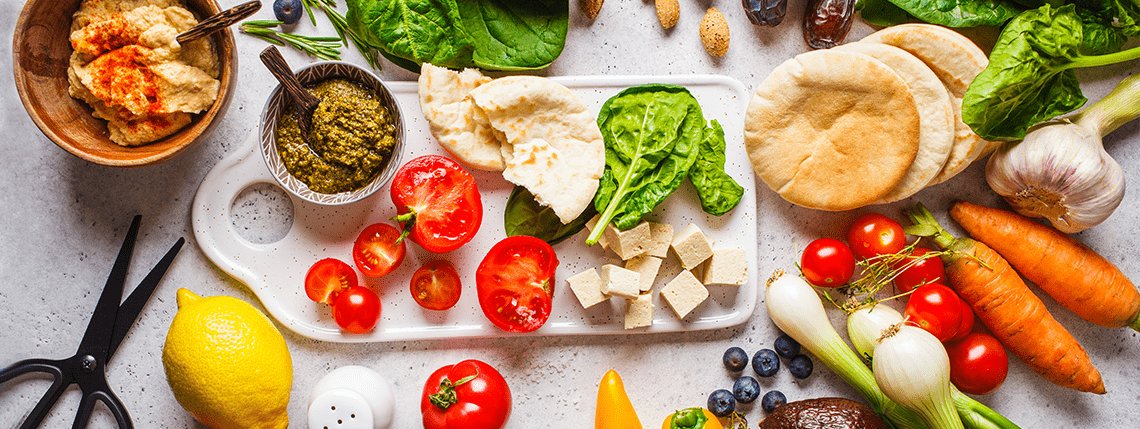Menopause is a natural and inevitable stage in every woman’s life. Linia Patel looks at how nutrition can help you get through it.
Menopause. A word feared by many women. Although it is a natural and inevitable stage in every woman’s life, over time the menopause has become associated with a lot of negativity. Some look at it as the beginning of the end. Others consider it a sense of loss. Yet others believe it’s a life filled with hot flushes, mood swings, weight gain, low libido, bone loss and just an overall decline in health. Add to this all of the conflicting ‘expert’ information out there and it’s becoming a really hard phase of life to navigate your way through.
What is menopause?
Menopause is a natural process that occurs as the ovaries age and produce fewer reproductive hormones. Medically, menopause occurs when a woman hasn’t menstruated for 12 consecutive months. There are many factors that will determine when you begin the menopause, including race, genetics, lifestyle and diet. The median age for menopause is 51. Although more research is needed, the menopause is thought to occur on average up to two years earlier for ethnic minority groups. Studies also show that smokers are more likely to have premature menopause than non-smokers1,2.
Nutrition and the menopause
During the transition of menopause and beyond, the hormone oestrogen begins to decline. Declining levels of both oestrogen and progesterone negatively impact on your metabolism, mood, sleep and bone density and increase your risk of diseases like heart disease. In addition, some women experience symptoms like hot flushes, fatigue and memory fog. Fortunately, making changes to the diet will help support the transition and may also help to relieve menopause symptoms1,2,3.
Although there are several dietary strategies for the menopause, this blog focuses on the importance of tapping into plant power during the menopause.
Plant power
Experts all over the world agree that perimenopausal women should eat more vegetables and fruits, wholegrains, beans and pulses, as well as nuts and seeds. There are many reasons for that. Firstly, there is strong research showing that areas where women consume more plants, less animal protein and less saturated fat have fewer and less intense perimenopausal symptoms, including hot flushes and weight gain. Plant-based foods are also high in fibre, which is key for your gut bacteria. The microbiome is a key lever in the body’s oestrogen levels. Certain bacteria that produce an enzyme called beta-glucuronidase can either increase or decrease oestrogen levels. Higher oestrogen levels mean a later onset of menopause but also lower levels of diabetes and common cancers like breast or endometrial cancer. One of the most effective ways to support the gut bacteria is by consuming more fibre. Recommendations are that you have 30g of fibre per day; however, clinical practice shows me that perimenopausal women should be aiming for about 35-50g of fibre per day to promote the good bacteria in your gut and cut back on the bloat3,4.
What about plant oestrogens?
Phytoestrogens are in certain plant-based food and can have oestrogen-like activity and a hormone-balancing effect on your body. Phytoestrogen-rich foods include pulses such as lentils, chickpeas and soya products. Over 300 foods, including fruits and vegetables, seeds, legumes and grains, have been found to have this oestrogenic effect; however, there are differences in the type and strength of the phytoestrogens1,2,3.
There are three kinds of phytoestrogens:
- Isoflavones: found in high concentrations in legumes such as soya, chickpeas and lentils
- Lignans: the highest amounts are found in flaxseeds (linseeds) but also in other oil seeds like sesame seeds, wholegrain cereals like rice, oats and wheat and vegetables like broccoli and carrots
- Coumestans: found in sprouted mung and alfafa beans
Isoflavones are particularly important when you are going through perimenopause or menopause. There are four different types of isoflavones: daidzein, genistein, biochanin and formononetin. What is interesting is that different legumes contain different ratios of isoflavones. Soya contains both genistein and daidzein; chickpeas and lentils contain all four. Now each of these isoflavones all have different benefits, so variety is the key! In eastern countries, where the research has shown that the main symptoms of perimenopause (hot flushes and weight gain) are significantly less, the average intake for isoflavones is 45mg per day compared to 2mg in the western societies2,3!
Summary of research on plant oestrogens
For some women, the research shows that a diet rich in plant oestrogens could be sufficient to help relieve menopause symptoms. It’s worth noting that4:
- it can take two to three months for the benefits of plant oestrogens to be seen
- it’s an individual thing – inclusion of plant oestrogens work better for some women than others, which is likely down to differences in gut bacteria
- consuming plant oestrogens several times a day appears to be more effective compared to one large dose
- variety is key!
Hormone-balancing Shakshuka
Serves 4
- Olive oil
- 1 large yellow onion, chopped
- 2 green peppers, chopped
- 2 garlic cloves, peeled, chopped
- 1 tsp ground coriander
- 1 tsp sweet paprika
- 1/2 tsp ground cumin
- Pinch red pepper flakes (optional)
- Salt and pepper
- 6 vine-ripe tomatoes, chopped
- 1/2 tin chopped tomatoes
- 4 eggs
- 100g tofu
- 1 can of mixed beans, drained
- 1/4 cup chopped fresh parsley leaves
- 1/4 cup chopped fresh mint leaves
- 1 tbsp ground flaxseed
Heat 3 tbsp olive oil in a large cast iron skillet. Add the onions, green peppers, garlic, spices, a pinch of salt and pepper. Cook, stirring frequently, until the vegetables have softened, for about 10 minutes. Add the tomatoes and chopped tomatoes and then the drained beans and cubes of tofu. Simmer until the tomato mixture begins to reduce, for about 10-12 minutes. Taste and adjust the seasoning to your liking. Using a wooden spoon, make 4 indentations, or ‘wells’, in the tomato mixture (make sure the indentations are spaced out). Gently crack an egg into each indentation. Reduce the heat, cover the skillet and cook on low until the egg whites are set. Uncover and add the fresh parsley and mint and 1 tbsp of ground flaxseed. You can add more black pepper or crushed red pepper.
Serve with a slice of wholegrain or seeded bread.
References
- Dunneram et al (2018), Dietary intake and age at natural menopause: results from the UK Women’s Cohort Study, Menopause, 72(8): 733-740.
- Nagata et al (2008), Dietary and lifestyle predictors of age at natural menopause and reproductive span in the Shanghai Women’s health Study, Menopause, 15(5): 924-33.
- Thangavel P et al (2009), Genistein as potential therapeutic candidate for menopausal symptoms and other related diseases, Molecules.
- British Dietetic Association Factsheet: Menopause,
https://www.bda.uk.com/resource/menopause-diet.html, accessed on 29 September
About the author

Linia Patel has a BSc degree in biochemistry and physiology. Since graduating in 2006, Linia has become a leading dietitian and sports nutritionist. She is currently a PhD candidate in public health. Her passion is translating nutritional science into easy-to-digest and practical advice. @liniapatelnutiriton
Where to next, why not try some tasty seasonal recipes HERE







